
The Surprising Benefits Of Combining Cannabis And Hot Peppers
Cannabis chills out the body and the mind. Peppers, in contrast, send a jolt through the central nervous system and wake up the senses. However, despite their differences, these two plant species work incredibly well together. Both contain phytochemicals that target the endocannabinoid system, making them a perfect pair when it comes to edibles.
Cannabis can soothe the mind, relax the body, and provide a fulfilling and creative experience. Hot peppers, in contrast, exert a burning sensation, activate sensory nerve endings tied to pain, and ignite a buzzing sensation through the release of dopamine.
Considering that, one would think the effects of these plant species are fundamentally different. However, in a different sense, cannabis and hot peppers interact with the body in a similar fashion, which makes them work surprisingly well together. Let's discover the similarities between these plants, how they both target the endocannabinoid system, and how to use them together.
Do Cannabis Plants and Hot Peppers Have Anything in Common?
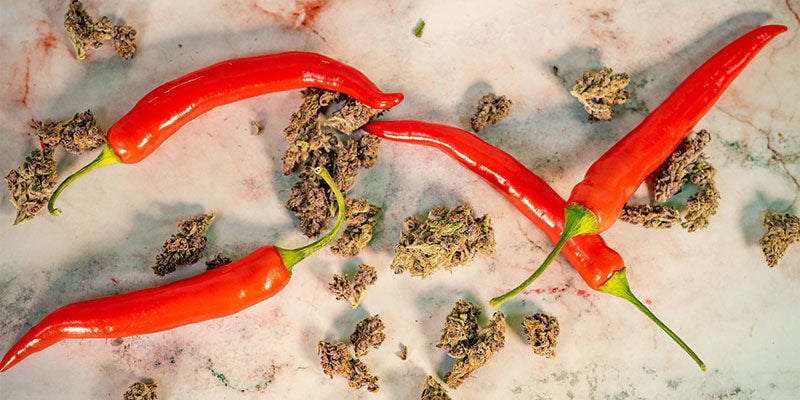
After smoking a joint, you’re likely to put on some music, talk deep with friends, meditate, or watch a movie. After eating a forkful of pepper-loaded food, you’ll probably spend the next few minutes guzzling milk, panting for relief, and wiping tears from your eyes.
So, how do these two plants share anything in common? Well, their commonalities lie in the chemicals they produce. Underneath the obvious sensations, the phytochemicals within these plants both target receptor sites that make up the endocannabinoid system (ECS).
The main "body" of the ECS consists of the CB1 and CB2 receptors, as well as internal cannabinoids that activate these receptors, along with the enzymes that synthesise and degrade them. Together, this system works in harmony to maintain the biological equilibrium of the body, known in short as homeostasis.
A plethora of molecules found within cannabis flowers mimic our own cannabinoids. For instance, THC mimics the endocannabinoid anandamide, enabling it to bind to the CB1 receptor to create its psychoactive effects. The cannabinoid and terpene beta-caryophyllene also achieves the activation of the CB2 receptor through this biomimetic action.
The expanded endocannabinoid system includes other molecules and receptor sites throughout the body. These include the transient receptor potential vanilloid subtype 1 (TRVP1), which is a site found in sensory nerve fibres, vascular cells, and smooth muscle cells. Other than detecting the heat of hot peppers, these receptors are also implicated in the regulation of physiological functions, such as inflammation, digestion, and temperature.
As the active constituent of hot peppers, the molecule capsaicin gives rise to the invigorating burning sensation after taking a bite of chilli-infused food. Capsaicin actively binds to the TRPV1 receptor, and thus acts as an agent that helps to activate the endocannabinoid system. The spicy molecule shares this trait with the non-psychoactive cannabinoid CBD. Through binding to this site, these molecules create physiological changes that help to soothe the body and relax the muscles.
Capsaicin can also help to further elevate happy neurotransmitters. After activating the CB1 receptor, THC causes a flood of dopamine into the brain and subsequently elevates the mood. Capsaicin also boosts dopamine, just through a different pathway. The body perceives the activation of TRVP1 as noxious stimuli, and releases endorphins to quell the pain. This chemical counter results in a buzzing or high that many hot pepper enthusiasts revel in.
How to Combine Hot Peppers With Cannabis in Food
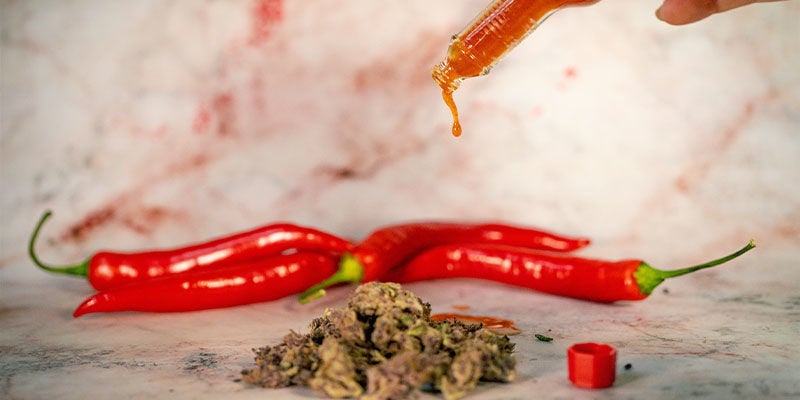
Edible cannabis produces a more pronounced high with a longer duration. You can easily add hot peppers into a cannabis-infused dish to provide an additional phytochemical kick. Recipes such as ganja hot sauce harness the endocannabinoid system-stimulating effects of both plants.
Adjust the quantities of cannabutter and hot peppers to create anything from a mild sauce that provides a light experience to one that sets the tongue ablaze and blasts the mind into another dimension. You can also add a combination of hot peppers and cannabutter to a whole range of other dishes, including curry, stir fry, pho, and chilli con carne.
What Are the Benefits of Hot Peppers in Food?
Aside from activating endocannabinoid system receptors, hot peppers are packed full of nutrients that fulfil different physiological roles within the body. These fiery fruits also benefit our gut, an organ that underpins the health of the human body.
Nutrition

While you endure the sensations of heat streaming across your tongue, you should know that you’ve just done your body a big favour. Hot peppers contain a vast array of vitamins, minerals, and other molecules. These include:
-
Vitamin C: Peppers contain high quantities of this essential nutrient and powerful antioxidant that helps to neutralise free radicals.
-
Vitamin B6: This key nutrient plays a fundamental role in turning the food we eat into usable energy and helps the nervous system and metabolism to function.
-
Potassium: Our bodies depend on this electrolyte to function properly. It enables nerves to fire and muscles to contract.
-
Copper: Found sparsely within the western diet, copper helps to form red blood cells, maintains healthy bones, and assists with iron absorption.
-
Lutein: Found primarily in young green chilli peppers, this nutrient plays an important role in eye health.
-
Capsanthin: A major carotenoid within hot peppers, this nutrient serves as a potent antioxidant within the body.
Gut Health
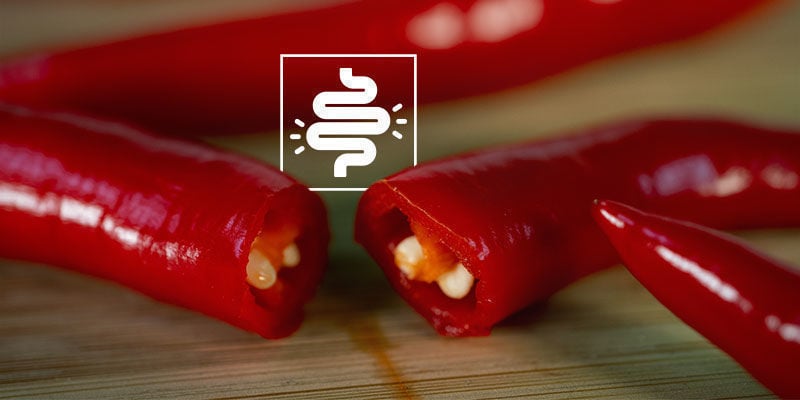
Far from a mere organ of digestion, the gut plays a fundamental role in our overall health. The gut hosts a large population of microbes that make up the microbiome. These organisms help to quench inflammation, defend against pathogens, and help us to digest food.
Disruption within the microbiome causes a state known as dysbiosis, which can go on to contribute to chronic health conditions. Interestingly, cannabinoids such as THC bind to the CB1 receptors in the gut and help to prevent a shift towards gut dysbiosis.
Capsaicin also interfaces with the endocannabinoid system in the gut. Through binding to TRPV1, the molecule increases levels of anandamide, which acts on the same cannabinoid receptor as THC. Capsaicin helps to modulate the endocannabinoid system in the gut by influencing the levels of our internal cannabinoids.
How Use Hot Peppers For Cannabis Companion Planting
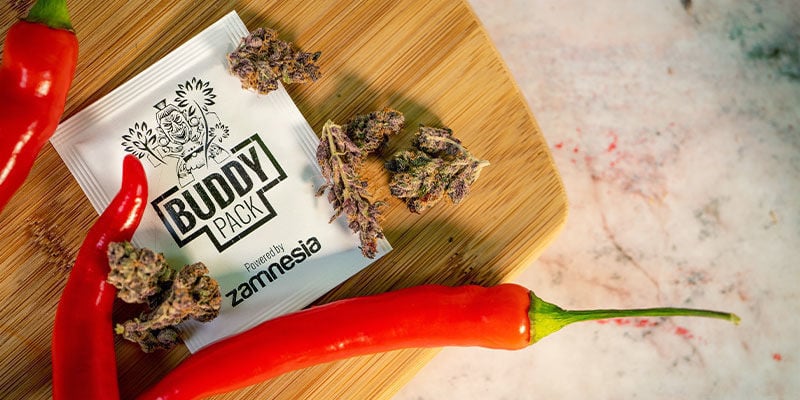
Hot peppers and cannabis also share a special relationship outside of the human body. As it turns out, the two plant species make perfect companion plants in the garden. As opposed to the monocultures found in large scale agriculture, home growers can harness the power of polycultures—the act of growing several species side by side—to enhance biodiversity and boost plant health.
Growers can plant hot peppers plants in close proximity to their weed crop, and both cannabis and peppers thrive in a warm and slightly humid climate. If you live in a warm region closer to the equator, the two will thrive together outdoors.
Simply transplant them into raised beds, with enough room to allow them to fully mature without getting into each other's way. If you live in a cooler climate, they’ll perform better together in a greenhouse or polytunnel. Plant them into beds or grow them close together in separate containers.
What Are the Benefits of Hot Peppers for Companion Planting?
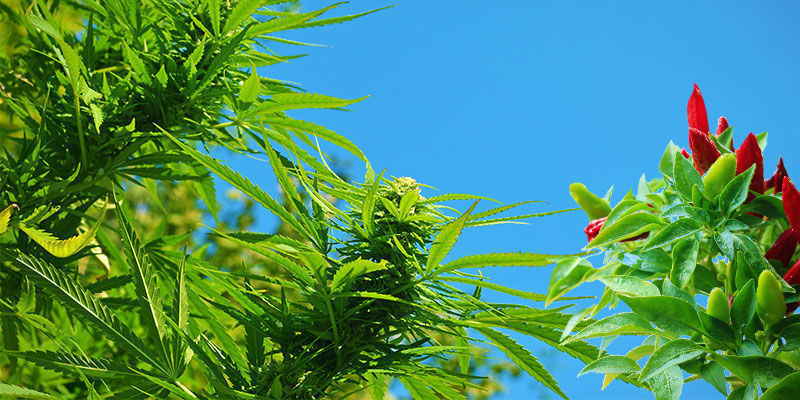
Both cannabis and hot peppers have unique effects on their immediate environment. These species form alliances with different beneficial microbes in the soil, so planting them together will improve the soil food web within your garden.
Hot peppers will also attract different insect species into your growing space. Bees have an affinity for peppers. These buzzing pollinators will do wonders for your garden and will help to fertilise your cannabis plants if you plan on breeding. On top of attracting the good guys, peppers also help to keep damaging insects at bay.
Pest Control
Capsaicin causes a burning sensation on the human tongue, so imagine what it does to insects. Hot peppers are effective at repelling certain pest species, including cannabis-loving cabbage loopers and spider mites. Growers can also use their pepper fruits to make their own natural insect repellants. Mix some powdered peppers with garlic, onion, and water. Blend the ingredients in a food processor, strain through a cheesecloth, and you have your own natural pest spray.
Low Impact
Hot pepper plants are one of many plant species that serve as great companions for cannabis. They offer a natural and organic way of keeping pests away from your valuable flowers. Instead of dousing your garden with damaging pesticides and killing the life in your soil, use the plants that nature provides to get the job done in the least harmful way.
Should You Smoke Hot Peppers With Weed?

So, since you're growing the plants together, should you smoke your hot peppers with your weed?
Absolutely not. Although peppers enhance many aspects of the cannabis plant, growers should never smoke their fruits. Capsaicin irritates the lungs to such a degree that law enforcement uses a weaponized form in mace sprays. The molecule also acts as the irritating ingredient in bear spray. Trust us, you don’t want to experience the sensation of capsaicin in your lungs. Never smoke your hot peppers.
How Do Other Foods Affect Cannabis?
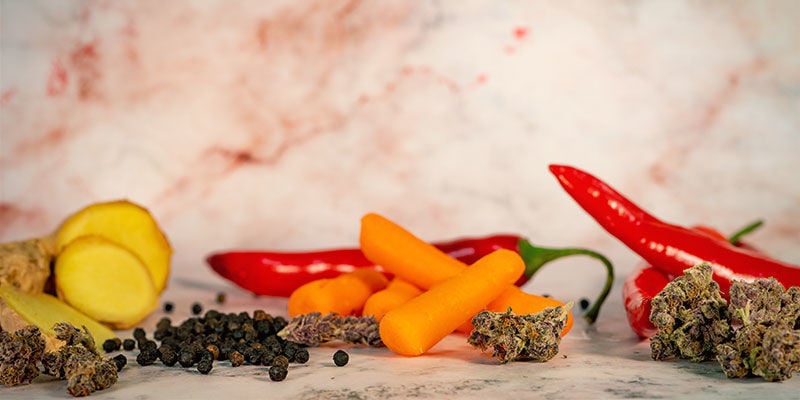
Peppers aren’t the only food that influences the endocannabinoid system and changes the way weed affects us. A whole host of plants influence our physiology in a similar way and both enhance and reduce the cannabis high. These include:
-
Black pepper: Piperine from black peppers helps to increase the absorption of CBD.
-
Rosemary and hops: These herbs contain beta-caryophyllene, a cannabinoid and terpene that activates the CB2 receptor.
-
Carrots: You read that right. These bright orange vegetables contain falcarinol, a molecule that binds to the CB1 receptor.
-
Echinacea: A herb often used to combat the common cold, echinacea contains alkamides that target the CB2 receptor.
-
Ginger: This spicy and warming herb contains the phytochemicals gingerol and zingerone which activate TRPV1, much like capsaicin.
-
Truffles: These expensive fungal lifeforms go down great in pasta dishes. They also contain anandamide, the endocannabinoid known as the “bliss molecule”.
Other plant species also work synergistically alongside cannabis in the garden. These companion plants help to attract beneficial insects, ward off pests, and increase the overall health of the growing space. These companion plants include:
Hot Peppers and Cannabis: The Perfect Match?
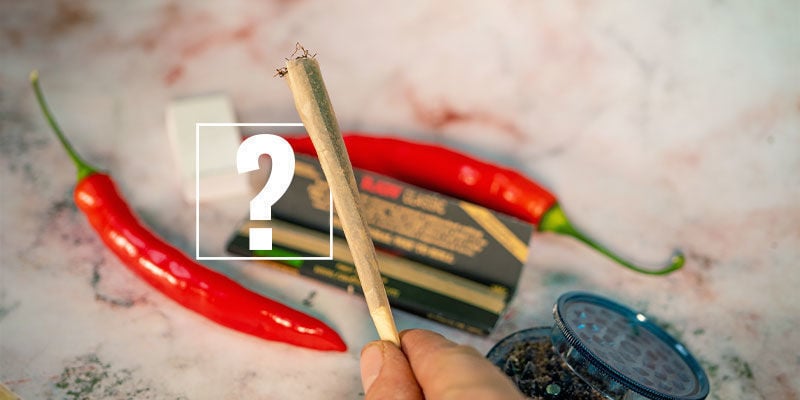
The research surrounding hot peppers, the endocannabinoid, and human physiology remains in the early stages. However, the data we have so far looks promising. As more science becomes available, hot peppers still have a place alongside cannabis, both in the kitchen and the garden.
- (n.d.). Scoping Review and Meta-Analysis Suggests that Cannabis Use May Reduce Cancer Risk in the United States - https://www.liebertpub.com
- (n.d.). Endocannabinoid system acts as a regulator of immune homeostasis in the gut | PNAS - https://www.pnas.org
- (n.d.). Beta-caryophyllene is a dietary cannabinoid | PNAS - https://www.pnas.org
- Du, Qian, Liao, Qiushi, Chen, Changmei, Yang, Xiaoxu, Xie, Rui, Xu, & Jingyu. (2019). Frontiers | The Role of Transient Receptor Potential Vanilloid 1 in Common Diseases of the Digestive Tract and the Cardiovascular and Respiratory System | Physiology - https://www.frontiersin.org
- Izgelov D, Domb AJ, & Hoffman A. (05/30/2020). The effect of piperine on oral absorption of cannabidiol following acute vs. chronic administration - PubMed - https://pubmed.ncbi.nlm.nih.gov
- Russo EB. (2016 Jul). Beyond Cannabis: Plants and the Endocannabinoid System - PubMed - https://pubmed.ncbi.nlm.nih.gov
- Russo EB. (2016 Jul). Beyond Cannabis: Plants and the Endocannabinoid System - PubMed - https://pubmed.ncbi.nlm.nih.gov
-
 4 min
11 June 2021
Can Black Pepper Help Manage the Effects of Cannabis?
Both black pepper and cannabis contain the terpene and dietary cannabinoid beta-caryophyllene. This molecule activates the CB2 receptor of the endocannabinoid system and produces relaxing and...
4 min
11 June 2021
Can Black Pepper Help Manage the Effects of Cannabis?
Both black pepper and cannabis contain the terpene and dietary cannabinoid beta-caryophyllene. This molecule activates the CB2 receptor of the endocannabinoid system and produces relaxing and...
-
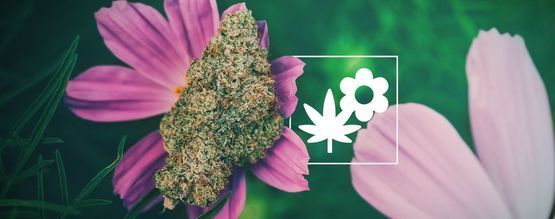 5 min
3 August 2020
How To Grow Better Cannabis With Companion Plants
Growing companion plants alongside your cannabis can provide numerous benefits for your growing operation. Along with improving soil conditions and providing nutrients, companion plants act as a...
5 min
3 August 2020
How To Grow Better Cannabis With Companion Plants
Growing companion plants alongside your cannabis can provide numerous benefits for your growing operation. Along with improving soil conditions and providing nutrients, companion plants act as a...
-
 2 min
3 November 2019
Combining Kanna with Weed or CBD: Should You Do It?
Weed and CBD are familiar favourites. Kanna is the new kid on the block: a plant-based psychoactive whose popularity is growing. Let's look at what happens when they join forces.
2 min
3 November 2019
Combining Kanna with Weed or CBD: Should You Do It?
Weed and CBD are familiar favourites. Kanna is the new kid on the block: a plant-based psychoactive whose popularity is growing. Let's look at what happens when they join forces.
-
 5 min
10 February 2018
Combining Cannabis And Coffee: Where To Begin?
Those looking for a different way to start their day should pay close attention. The combination of cannabis and coffee has long been a talking point. On the surface, both offer opposite effects,...
5 min
10 February 2018
Combining Cannabis And Coffee: Where To Begin?
Those looking for a different way to start their day should pay close attention. The combination of cannabis and coffee has long been a talking point. On the surface, both offer opposite effects,...





 United States
United States











